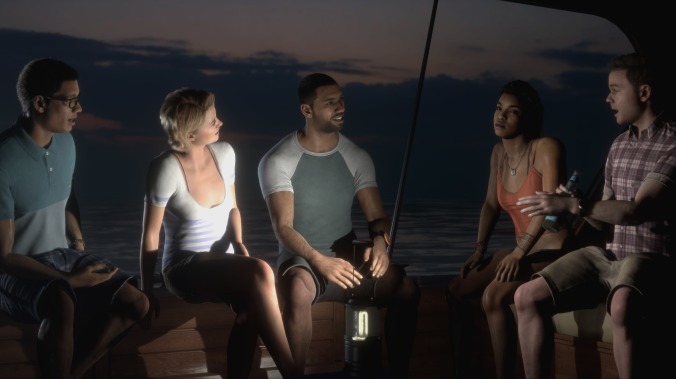The versions of Man Of Medan you don’t play are way more interesting than the one you do
Games Reviews Game Review

I had nothing all that charitable to say about Man Of Medan until I played it for the second time. This isn’t because I had more fun returning to it, or discovered some previously unknown tactic to victory, or managed to “win” by whatever parameters you could consider to be winning this choose-your-own-adventure tale (though I definitely won). No, it’s because, by returning to the same narrative for a repeat performance, I discovered just how much more interesting the road not taken could be than the one I ended up traversing.
The Dark Pictures Anthology: Man Of Medan is the new game from the creators of Until Dawn, the most entertaining slasher movie of 2015 that also happens to be a video game, albeit one that used Supermassive’s Butterfly Effect system, in which every little decision you make or action you choose is tracked and used to alter the story that unfolds. That game felt like a fun night on the couch watching a hacky (and hack-y) B-movie, in which a cast of stock horror types got offed one by one, with the major difference being that you got to play god and try to shape who lived and died. It contained some gorgeously rendered graphics, excellent actors, and a deliciously campy fourth-wall-breaking therapist in the form of Peter Stormare, who led the player down an increasingly dark path and provided meta commentary. It was awfully generic in story and dialogue, but that felt like an intentional choice, part and parcel of the cheesy horror experience whose stereotypes it wanted to play with. What Man Of Medan suggests, unfortunately, is that maybe Supermassive just isn’t very good at writing decent characters. Maybe cliched and clumsy dialogue is all there is.
And guess what? It actually turns out that having good actors is vitally important when trying to sell such half-baked writing. Until Dawn had Hayden Panettiere, Brett Dalton, and future Oscar winner Rami Malek; Man Of Medan’s lead characters had trouble convincing me that they knew their own names, let alone believed anything they were saying. Which is a problem when they’re fighting for their lives: The game features a group of five twentysomethings who charter a small boat to explore an undiscovered wreck they’ve somehow stumbled upon in the South Pacific, only to discover coordinates that might lead to long-forgotten treasure. Unfortunately, they’re soon beset by a trio of desperate men who decide the best way to recover the loot is to bring their captives along—but the decaying abandoned ship they end up exploring turns out to be harboring something much more deadly than rusty doorways.
The first time through, I played Man Of Medan in “Movie Night” mode, which is what Supermassive has termed the way people were actually playing Until Dawn—namely, by hanging out in groups and passing around the controller as the narrative unfolded, controlling different characters. And in this respect, the game is inferior in almost every way to its predecessor. While it spreads the action more evenly among its characters, there’s less to actually do; long stretches go by in which it feels as though little changes, and more than a few exchanges seem to be more about bolstering the wafer-thin personalities and relationships of its protagonists than actually letting you decide stuff. Long-distance couple Alex (Kareem Tristan Alleyne) and Julia (Arielle Palik) are dull, while Alex’s brother, Brad (Chris Sandiford), is such a generically drawn nerd that he may as well have a little digital pocket protector. Along with Ayisha Issa’s owner and pilot of their rental boat, Fliss, the only one who really breathes life into their character is Shawn Ashford (Iceman himself from the X-Men movies), hamming it up as Julia’s wealthy and obnoxious ass of an older brother, Conrad.
Moving from one situation to the next, Man Of Medan has a tendency to feel like a series of cut scenes strung together with the occasional game, as opposed to the other way around. What came across as intentionally cheesy now seems more like bad writing; even the fairly intriguing reveal of what’s actually happening on the eerie ship gets fumbled unless you make the right choices to have Brad—the only character who comes off as smart or attentive enough to figure things out—be the one to piece together the mystery. And Peter Stormare’s juicy central role as the witness to your actions has been replaced by a curator (Preacher’s Pip Torrens), who delivers both less interesting meta insight to your actions, and far fewer interactions. It’s as though the creators wanted to do the same thing that made Until Dawn such cheesy fun, but had no idea had to make it as compelling the second time around.
And yet, a second time through was the very thing that salvaged Man Of Medan. First of all, playing the online cooperative mode opens up the game in a far more interesting manner: While you’re off exploring the underwater wreck, or venturing into some strange new corner of the ship, your remote friend will be dealing with a completely different scenario in some other part of the landscape. There are plenty of times you’re both in the same place, of course, but just by virtue of these simultaneous split narratives taking place, the game opens up a world of possibilities for how to play, since unless you keep a running commentary of what’s happening, you’re effectively in the dark as to what’s transpired in your buddy’s game. (Given that the game spends a lot of time on mystical visions or hallucinations, the feeling of reacting to something on your screen that your partner literally didn’t see is about as close as the game gets to actual scares.) Not only that, but when it comes time to answer a question or make a choice, all that you’ll see when it’s another player’s turn is the notice that “So-and-so is deciding” in the upper right corner, and then the scene proceeds. All of that brings something interesting to what is otherwise a fairly uninvolving experience.
But it’s in consideration of how the outcome changed, and why, that Man Of Medan becomes genuinely intriguing. It’s essentially a garden of forking paths, and watching the profoundly different outcomes take shape demonstrated that there’s actually a lot going on below the surface of what looks like a deeply shallow game. A character I thought couldn’t be saved had a wholly different storyline upon the subsequent play. And making alternate decisions doesn’t just result in the same situations with different characters slotted in (though there are a few of those); there are entirely separate sequences that do or don’t happen, and bold shifts to the action itself—not just the ending—based on key choices as you move through the story. I had more fun treating the game as a flow chart, and mentally breaking down the various patterns and cause-and-effect deviations to the decision tree, than I did simply playing.
And that’s admittedly a problem. A game should foremost be entertaining on its own merits. Man Of Medan, the first in a promised series of stand-alone horror games for the Dark Pictures anthology, does everything Until Dawn did, only worse. (Even the opening credits feature an almost-too-corny-too-be-true goth emo-metal anthem that Evanescence would’ve listened to and said, “Eh, maybe not for us.”) It’s not until you start playing around with the possibilities of the online co-op mode, and going over and over the different choices, that it offers pleasures in the complex calculations of its Butterfly Effect system. The fun lies more in the thought experiment of reflections on its myriad mechanics, and not in the murky depths of its spooky seafaring setting.